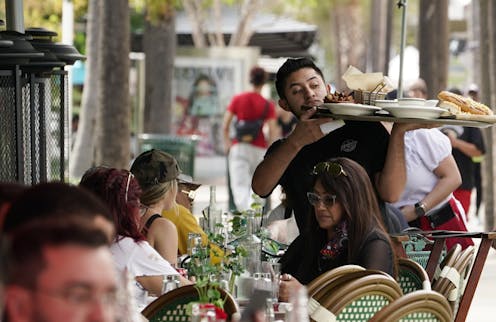Massachusetts could be the next state to get rid of the ‘subminimum wage’ for tipped workers
It’s unclear what raising the tipped minimum wage or getting rid of it altogether does to labor markets.

The federal minimum wage for tipped workers has stood at US$2.13 an hour since 1991. Back then, it amounted to half the $4.25 regular minimum wage. But Congress has failed to increase the tipped minimum while periodically raising the regular wage floor. Today, the tipped rate is less than one-third of the $7.25 federal full minimum wage.
As of October 2024, 30 states and Washington, D.C., had instituted their own, higher, regular minimum wages. The number of states taking this step keeps rising in part because Congress hasn’t raised the federal minimum wage since 2009. Over the years, many states have also adopted higher wages for tipped workers. Seven states have no tipped minimum wage at all, which means that employers must pay at least the state-mandated minimum wage to all workers, including those who earn tips.
If Massachusetts voters approve a ballot initiative on Nov. 5, 2024, their state will gradually raise the state’s tipped minimum wage until it matches the state minimum wage. That is, it will rise from $6.75 to $15 per hour by 2029.
Massachusetts would be joining eight states that require – or are on their way to requiring – the full minimum wage for tipped workers: Alaska, California, Minnesota, Montana, Nevada, Oregon, Washington and Michigan. Two major cities, Chicago and Washington, D.C., have similar measures on their books, too.
To inform the debate about tipped wages, we – a labor economist and a sociologist – analyzed the potential impacts of implementing a full minimum wage for workers, businesses and consumers in Massachusetts. We found more evidence of potential upsides than downsides.
Tipped minimum earners’ demographics
For our study, we analyzed labor market data from the Bureau of Labor Statistics. We found that tipped workers are largely waiters, bartenders, hosts and bussers employed in bars and restaurants. They tend to earn low wages. Most are women, and they are disproportionately people of color.
In Massachusetts, tipped workers typically earn low pay: On average, they take home $20.30 per hour, including what they get in gratuities. That’s about two-thirds of the state average hourly pay of $31.50.
About 66% of tipped workers are women, compared with 49% in the state’s workforce as a whole. Some 43% are people of color, compared with 29% of all people employed in Massachusetts.
Teens also make up a disproportionate share of Massachusetts’ tipped workers: 15%, versus 4% for the broader workforce. But the vast majority of tipped workers are at least 20 years old.
Arguments for and against
Proponents argue that eliminating the tipped minimum wage would boost pay for tipped workers and better ensure that workers are not subjected to wage theft. U.S. Sen. Elizabeth Warren of Massachusetts wants the federal government to take this step.
Opponents argue that scrapping the lower minimum wage could backfire for tipped workers if their customers give smaller tips once they know employers have to pay tipped workers more – or some jobs are eliminated. They also worry that business costs would spike, raising prices. Massachusetts Gov. Maura Healey, a Democrat, opposes the measure.
In Arizona, voters will cast their ballots on another ballot initiative that calls for a different type of tipped minimum wage reform. It calls for pegging the state’s tipped minimum wage to 25% below the full minimum wage. If approved, Arizona would effectively lower its tipped minimum wage, which currently stands at $11.35 an hour, to $10.76. Today, Arizona’s tipped minimum wage is $3.00 below the state’s full minimum wage of $14.35.
Prone to wage theft
When tipped workers’ base wages plus their tips do not add up to at least the state’s minimum wage, employers are supposed to make up the shortfall. This makes these workers particularly vulnerable to being underpaid, a form of wage theft.
The consequences of this vulnerability are plain to see in restaurants and hotels. The hospitality industry, which employs the highest share of tipped workers, accounts for less than 6% of employed workers in Massachusetts.
However, it accounts for nearly 14% of all complaints workers lodged with the Massachusetts attorney general’s office in 2023, including disproportionately high levels of complaints about minimum wage violations, the nonpayment of wages and tip violations.
The hospitality industry also accounts for over 36% of all enforcement actions – investigations that produced evidence of labor violations – found by the Massachusetts attorney general’s office.
Effects on earnings
Two peer-reviewed economic studies that examined three decades of data found that tipped workers earn measurably more money as subminimum wage rates increase.
Current wage rates that we observe in Bureau of Labor Statistics data reinforce those findings.
Consider, for example, the $18.79 average hourly wage of tipped workers in states that treat tipped employees like other workers. This is 21.2% higher than the average $15.50 among tipped workers in states where the federal $2.13 subminimum wage remains in effect.
Only part of this difference can be explained by the 15.7% difference in average wages for all workers in those different clusters of states.
What could happen with business costs
To be sure, more than doubling the $6.75 tipped rate in Massachusetts to $15.00 may sound like it could cause business costs to soar. A couple of factors, however, would soften the blow.
First, we have calculated that the average tipped worker in Massachusetts restaurants earns about $11.75 an hour, before tips. Raising this rate to $15.00 is equal to a 28% increase – a much smaller lift than increasing the wage from $6.75 to $15.00. In addition, raising a worker’s wage from $11.75 to $15.00 by 2029 is equivalent to raising it to $13.00 in today’s dollars, or a 10% boost, after adjusting for projected inflation.
Second, as we explained in our study, since tipped workers make up about 30% of Massachusetts restaurant workers, and the payrolls of these businesses typically amount to about 30% of their revenue, these numbers imply that eliminating the tipped minimum wage by 2029 would increase the average Massachusetts restaurant’s costs by 1%.
Employers may also provide some other workers with raises, although they are not required to do so. That suggests the cost increase is more likely to be about double that, or 2% of sales.
Expected impact on prices and jobs
If the average Massachusetts restaurant were to pass its entire labor cost increase onto the consumer through higher prices, this would mean that restaurant prices would rise about 2%.
This is equal to a $50 restaurant meal instead costing $51 – arguably a small price increase.
The two studies mentioned above, which reviewed decades of data to see whether tipped workers earned more, also looked at whether businesses in states that increased their tipped minimum wage cut more jobs compared with businesses in states that didn’t.
Although both research teams looked at basically the same data, one study found evidence of more job losses and the other did not, due to the different statistical choices they made. These studies, that is, produced inconclusive results about what raising the tipped minimum wage does to employment.
There’s far more research on whether increasing the regular minimum wage has caused significant job losses. Studies have found that when it has gone up, employers have faced cost increases that are similar to what we’ve estimated for Massachusetts employers, if the state were to eliminate its tipped minimum wage. And that evidence points to no significant job losses.
The authors do not work for, consult, own shares in or receive funding from any company or organization that would benefit from this article, and have disclosed no relevant affiliations beyond their academic appointment.
Read These Next
Drones, physics and rats: Studies show how the people of Rapa Nui made and moved the giant statues –
The mysteries of Easter Island, subjects of speculation for centuries, yield to scientific inquiry.
As US hunger rises, Trump administration’s ‘efficiency’ goals cause massive food waste
Despite the administration’s claim of streamlining the government to make its operations more efficient,…
A year on, the Israeli-Lebanese ceasefire looks increasingly fragile − could a return to cyclical vi
Since the start of the truce on Nov. 27, 2024, there have been thousands of Israeli violations inside…





